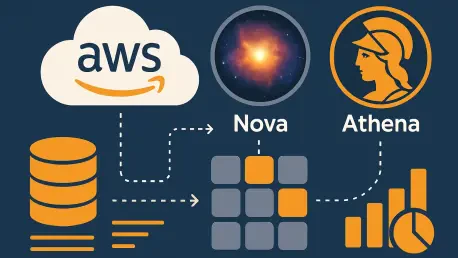In an era where data drives decision-making across industries, the challenge of making complex datasets accessible to non-technical users has never been more pressing, and Amazon Web Services (AWS) has taken a significant leap forward by integrating its innovative Nova foundation models with Amazon Athena, a serverless query service designed for analyzing data in Amazon S3. This groundbreaking development introduces a conversational interface that allows users to interact with vast data lakes using plain English, effectively dismantling the barriers posed by traditional SQL queries. By leveraging natural language processing and voice interaction, this integration promises to democratize data analytics, enabling professionals from diverse backgrounds to extract meaningful insights without requiring deep technical skills. The implications of this advancement are profound, reshaping how enterprises approach data-driven strategies and operational efficiency.
Breaking Down Barriers with Natural Language Queries
The fusion of AWS Nova models with Amazon Athena marks a pivotal shift in how data queries are conducted, particularly through the power of natural language processing (NLP). Users can now pose questions in everyday language, such as inquiring about quarterly sales averages, and the system translates these into precise SQL commands for execution. Hosted via Amazon Bedrock, a managed service for deploying Nova models, this setup employs lightweight variants like Nova Lite or Flash to ensure both speed and cost-effectiveness. Beyond mere translation, the system is designed to handle ambiguity by engaging users for clarification when needed, replicating the nuanced interaction one might expect from a human data analyst. This approach not only simplifies the querying process but also empowers individuals without coding expertise to dive into data analysis, fostering a more inclusive environment within organizations where insights are no longer confined to technical teams.
Another layer of innovation lies in the seamless integration that prioritizes user experience and operational flow. As enterprises increasingly rely on data for strategic decisions, the ability to quickly interpret and act on information becomes critical. The conversational interface provided by Nova and Athena reduces the learning curve associated with traditional database querying tools, allowing employees across departments to contribute to data-driven initiatives. Moreover, the system’s adaptability ensures that it can handle a range of query complexities, from straightforward data retrieval to more intricate analytical tasks. This versatility positions the technology as a vital asset for businesses aiming to maximize their data potential while minimizing dependency on specialized IT resources, ultimately driving productivity and innovation across the board.
Voice Interaction and the Future of Hands-Free Analytics
One of the most striking enhancements brought by AWS Nova is the incorporation of voice interaction through the Nova Sonic model, enabling hands-free data querying with Amazon Athena. Imagine a warehouse manager verbally requesting inventory trends while on the move, receiving immediate audible responses without needing to interact with a screen. This feature, bolstered by partnerships with communication platforms and frameworks like LiveKit’s WebRTC, supports low-latency, real-time voice interactions that can be embedded into custom applications. Such advancements cater to dynamic work environments where speed and accessibility are paramount, offering a glimpse into how data analytics can evolve beyond traditional interfaces. The potential for voice-driven queries to streamline operations in sectors like logistics and retail is immense, paving the way for more agile and responsive workflows.
Expanding on this, the introduction of voice capabilities also hints at broader implications for user engagement with data systems. Beyond mere convenience, the technology opens doors to scenarios where emotional nuances or contextual understanding could play a role in interactions, as some industry discussions suggest. While still in early stages, the exploration of such features through Nova Sonic reflects a forward-thinking approach to human-AI collaboration. Additionally, the ongoing research into models like Nova Act, which focuses on browser-based automation, indicates that future iterations might not only interpret data requests but also execute related tasks autonomously. This trajectory toward agentic AI underscores a transformative trend where analytics tools become active participants in decision-making processes, enhancing efficiency in ways previously unimagined across various industries.
Addressing Challenges and Ensuring Scalability
While the integration of AWS Nova with Athena offers remarkable benefits, it is not without challenges that need careful consideration. Ensuring the accuracy of queries, especially in ambiguous scenarios, remains a critical concern, as does safeguarding data security during conversational exchanges. AWS addresses these issues through Bedrock’s built-in guardrails, designed to minimize risks such as biases in generated SQL code. However, industry experts emphasize the importance of continuous monitoring and refinement to maintain trust in the system’s outputs. The balance between accessibility and precision is delicate, yet crucial for widespread adoption in environments where data integrity is non-negotiable, such as financial services or healthcare, where even minor errors can have significant repercussions.
Scalability and cost-effectiveness further enhance the appeal of this technology for enterprise applications. Amazon Athena’s pay-per-query pricing model, combined with Nova’s competitive performance benchmarks, ensures that businesses can manage large-scale data lakes without the burden of extensive infrastructure costs. This synergy allows organizations to scale their analytics capabilities in line with growing data demands, supporting everything from small departmental projects to company-wide initiatives. The focus on efficiency extends to integration with other AWS tools like QuickSight for dashboards and SageMaker for machine learning, creating a cohesive ecosystem that amplifies operational impact. As companies navigate the complexities of big data, such solutions provide a robust foundation for sustained growth and adaptability in an increasingly data-centric landscape.
Reflecting on a New Era of Data Interaction
Looking back, the integration of AWS Nova models with Amazon Athena redefined how enterprises approached data analytics, setting a precedent for accessibility and intuition in querying vast datasets. The strides made in natural language processing and voice interaction through tools like Nova Sonic demonstrated a clear shift toward user-centric design, enabling professionals across various fields to engage with data effortlessly. Challenges such as query accuracy and security were met with proactive measures, reflecting a commitment to reliability that bolstered confidence among early adopters. For those considering the next steps, exploring how these tools could be tailored to specific industry needs or integrated with existing workflows offered a practical path forward. As the landscape of AI-driven analytics continued to evolve, staying attuned to emerging capabilities and addressing potential limitations remained essential for harnessing the full potential of conversational data systems.









